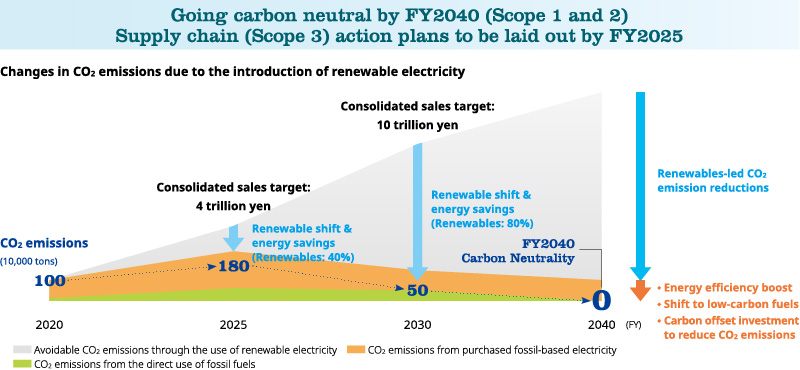Special Feature 2021 - Integrated Report 2021
Outline of the Medium-Term Strategic Goal
The new medium-term strategic goal Vision 2025 is a milestone for achieving consolidated net sales of 10 trillion yen by FY2030. In Vision 2025, we plan to increase consolidated net sales to two trillion yen by FY2022 and to four trillion yen by FY2025. We anticipate an increase in consolidated net sales through new M&A deals (by approximately one trillion yen) in addition to organic growth centered on growth fields in existing businesses.

Review of Vision 2020 and Road to Vision 2025
Consolidated net sales in FY2020 were 1,618.1 billion yen, and we failed to reach the consolidated sales target of two trillion yen, which we aimed to achieve in the medium-term strategic goal Vision 2020 covering the period FY2015 to FY2020. In Vision 2025, we aim to achieve consolidated net sales of four trillion yen by FY2025 after attaining consolidated net sales of two trillion yen, which was the target value in Vision 2020, by FY2022. The features of Vision 2025 are listed on the right.
- 1. Incorporation of productivity improvement to the goal: We aim to increase sales and operating profit per employee by 30% by FY2022 and double them by FY2025.
- 2.Incorporation of the ROIC target: In Vision 2020, ROE (return on equity) was used as a management index. In Vision 2025, an ROIC (return on invested capital) of over 15% has been set as the final target.
- 3.Setting of ESG goals: ESG-related items are incorporated as new goals. Initiatives to achieve carbon neutrality and strengthen governance have been expressly adopted as ESG goals.
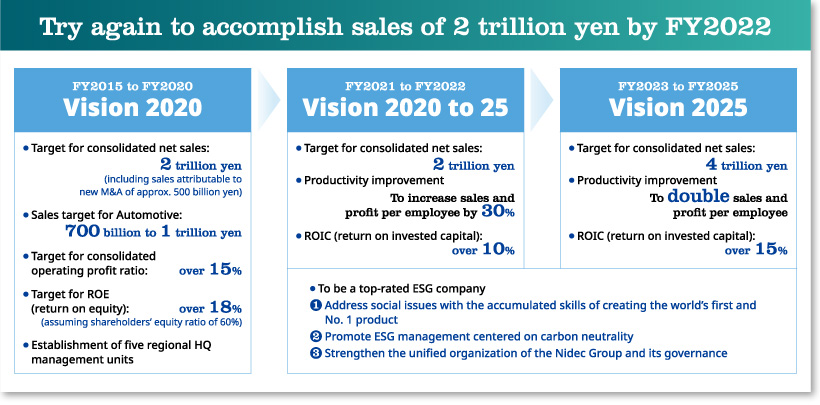
Framework for the New Medium-Term Strategic Goal 1
Commitment to Profitable Small Precision Motor Department Growth
To achieve consolidated net sales of four trillion yen (including one trillion yen expected to be gained through new M&A deals) by FY2025, we are required to attain a high growth rate. We are committed not only to increasing sales but also to achieving profitable growth. Accordingly, we have adopted ROIC (return on invested capital) as a management index in Vision 2025 instead of ROE (return on equity) in Vision 2020, and have set the ROIC target at 10% or more in FY2022 and 15% or more in FY2025.
For existing businesses, we will seek growth opportunities through management in a business and geographic scope (visualizing business opportunities by creating a matrix of prod-ucts by business and region), while pursuing optimization of capital efficiency by using ROIC as the evaluation axis. The main focus of new M&A deals is to complement our technologies and commercial distribution services required for our strategy to succeed. We place an emphasis on M&A deals that not only lead to an increase in sales but also have a synergistic effect with our management strategy and eventually contribute to improving the management indicators of the entire company.
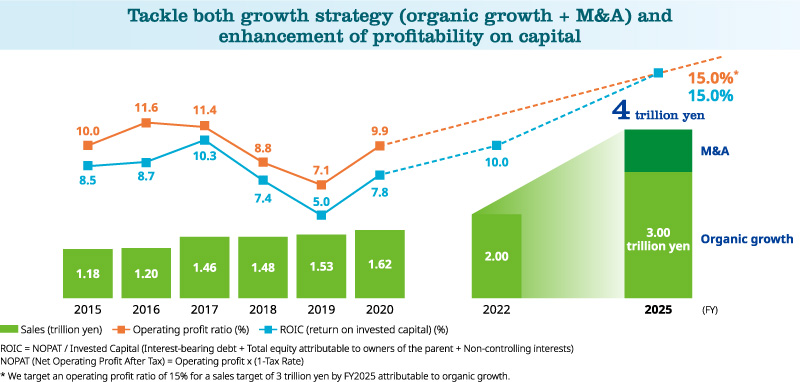
Framework for the New Medium-Term Strategic Goal 2
Business Portfolio Management
Consolidated net sales for FY2020 were 1.6 trillion yen. To achieve the consolidated sales target of four trillion yen by FY2025
(including one trillion yen expected to be gained through new M&A deals), we will actively shift our focus to growth businesses.
In the automotive department, we have secured orders for 3.5 million units in the E-Axle business, whose market is expected to expand significantly in the future, and we expect sales to increase by several hundred billion yen by FY2025. In addition, there are many product groups, such as electric power steering (EPS) motors, whose annual sales growth rate can be expected to exceed 10% on an order basis. The automotive business is expected to have a high sales growth rate as a whole.
In the small precision motor department, we cannot expect significant sales growth for HDD motors, which have been the driving force behind our business performance for many years. We will shift management resources to the mobility field, such as motors for small EVs, for which business opportunities are expected to expand due to automotive electrification, and motors for electric two-wheeled vehicles. Thus, we hope that these products in the mobility field will contribute to sales growth together with heat management systems, which is another growth field.
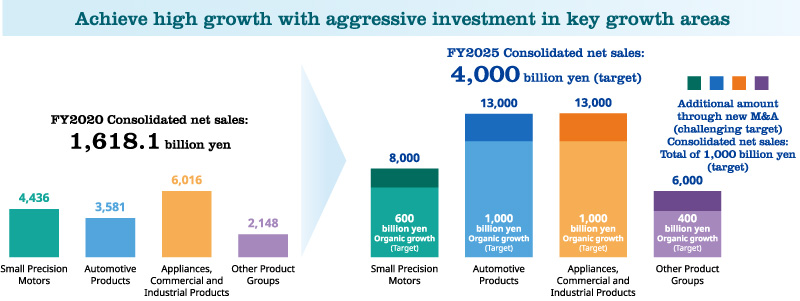
Framework for the New Medium-Term Strategic Goal 3
Measures for Boosting Top-Line Growth
To achieve consolidated net sales of four trillion yen by FY2025 and consolidated net sales of 10 trillion yen by FY2030, it will be necessary to shift to a business field with a larger market size. By not only shifting our business to growth fields but also providing products with a high level of integration for customers, we will be able to access larger markets and increase product unit prices.
Taking the automotive business as an example, it will be possible to access higher value-added markets as the product integration level increases from the provision of motors alone (device alone) to the provision of power packs for electric power steering (EPS) systems and electric oil pump modules (module), E-Axles (system), and EV platforms (solution).
By advancing this transition process in each business depart-ment, we will secure the growth opportunities necessary to achieve consolidated net sales of 10 trillion yen by FY2030.
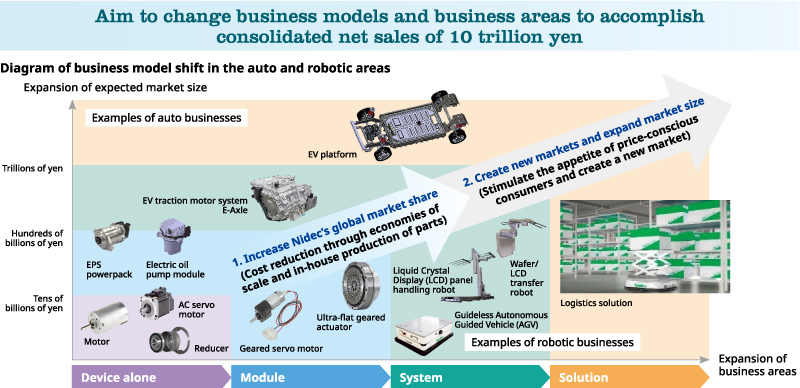
Framework for the New Medium-Term Strategic Goal 4
Basic Policy for EV Traction Motors
The environment surrounding the EV industry is changing day by day, and major changes are occurring such as the promotion of automotive electrification due to the tightening of environmental regulations around the world, entry into the EV market from different industries, and the emergence of fabless manufacturers.
We anticipate an explosive increase in the sales of EV traction motors after 2025 mainly due to a decline in EV prices caused by a decrease in battery prices. We have already secured orders for 3.5 million E-Axle units for FY2025, and we expect their sales to reach 10 million units in FY2030. At present, most E-Axles are manufactured in-house by auto manufacturers. However, as the number of EVs increases, there will be a shift from in-house manufacturing to outsourcing. To expand the market for E-Axles, we plan to invest a total of one trillion yen (in CAPEX and M&A) on a consolidated basis by FY2025, with the aim of improving their price competitiveness and manufacturing system. We are also considering establish-ing a joint venture with the Hon Hai Group in light of the fact that fabless manufacturing of EVs is promoted mainly by new entry manufacturers.
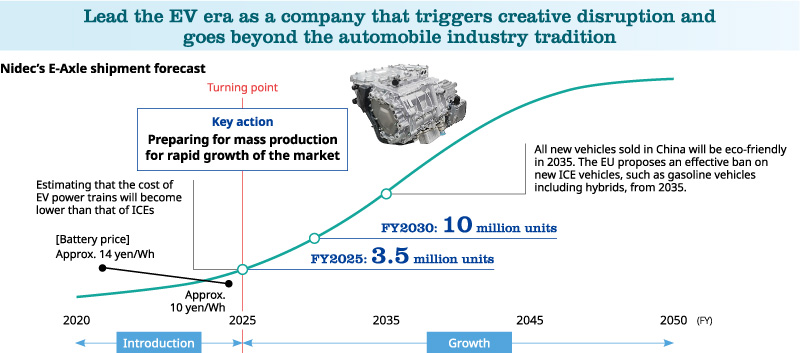
Framework for the New Medium-Term Strategic Goal 5
ROIC Management
In Vision 2025, ROIC (return on invested capital) has been included as a new management index, and specific activities to improve ROIC will be implemented based on numerical targets in line with the strategy of each business department. For instance, since the small precision motor department and the automotive department have different customer bases and different business lead times, there is a difference in the measures required to improve ROIC and in the timeline until the measures produce results. It is important to implement improvement activities based on the characteristics of each department.
To improve ROIC, it is necessary to increase profitability and optimize invested capital. Accordingly, we will take concrete measures for each business department. Specifically, we will improve the cost to sales ratio and the factory utilization ratio to increase profitability, and shorten the CCC (cash conversion cycle) and promote production automation to optimize invested capital.
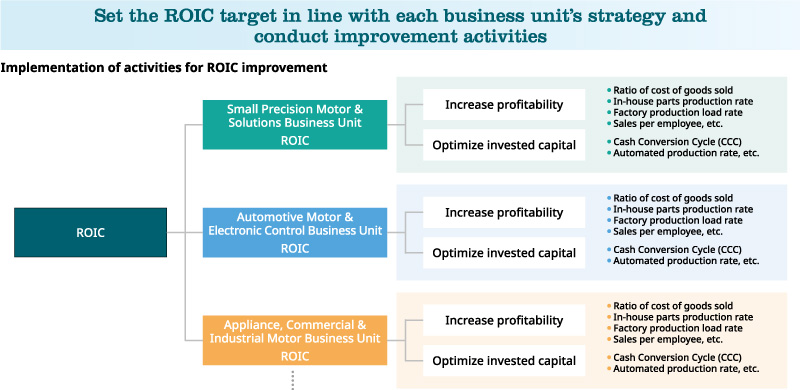
Framework for the New Medium-Term Strategic Goal 6
Pathways to Carbon Neutrality
In Vision 2025, we have newly declared the goal of achieving carbon neutrality. Our declaration consists of two goals: ① achieving carbon neutrality for business activities (Scope 1 and 2) by FY2040 and ② laying out a plan to reduce CO2 emissions in the supply chain (Scope 3) by FY2025.
Energy consumption is expected to rise in proportion to an increase in sales. To address this, we plan to reduce net CO2 emissions to zero by FY2040 (Scope 1 and 2) by ① promoting energy saving, ② shifting to renewable energy sources in the energy mix, and ③ investing in carbon offset projects. The percentage of our total energy consumption sourced from renewables is planned to be 40% by FY2025 and 80% by 2030.
